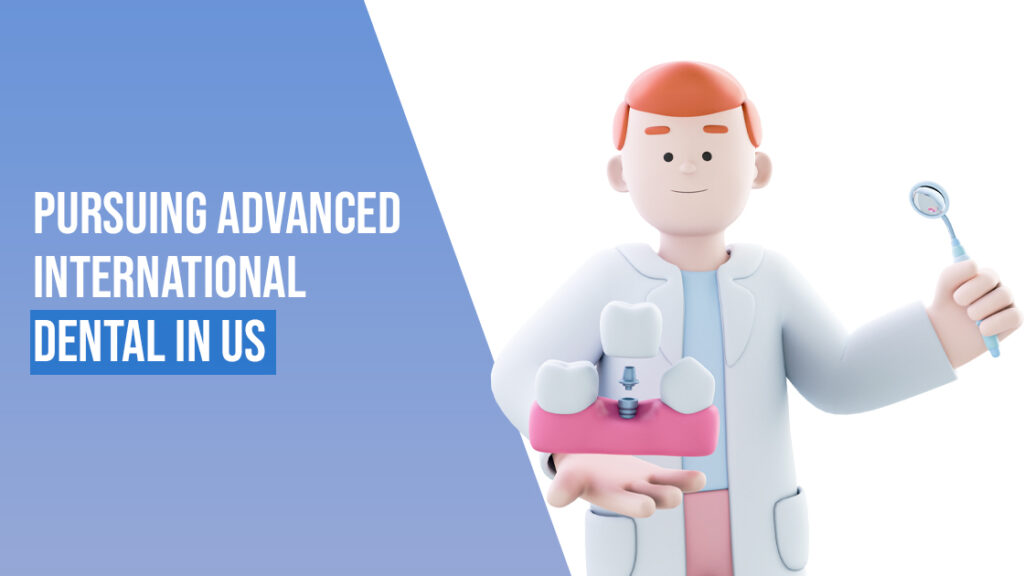INTRODUCTION
Imagine the CAAPID process as a dental appointment that you need to undergo, to receive a clean bill of health to proceed. The TOEFL serves as your dental check-up, ensuring your English language skills are “cavity-free”, and that you are ready to take on the academic CAAPID adventure that awaits you. Before you can soar, you must navigate your way through the linguistic landscape TOEFL offers. “What is TOEFL? How do I prepare?”- let us embark and delve deep into this TOEFL odyssey together.
TOEFL
a. What is TOEFL?
The Test of English as a Foreign Language, commonly referred to as “TOEFL”, is a standardized English language test designed to measure your proficiency and your ability to incorporate the English language in an academic/professional setting. It is a pertinent and integral aspect of several university applications. It is a widely accepted and recognized measure of English proficiency by several institutions, including CAAPID.
b. A breakdown of what TOEFL assesses
1. Reading: Your ability to comprehend academic texts and provide answers based on the questions the information presents you with.
2. Listening: The test also assesses your ability to hear or “listen” to academic lectures, conversations, and regular spoken English conversation materials, and understand them.
3. Speaking: Your ability to express yourself clearly and coherently, in spoken English.
4. Writing: Your ability to write academic material like essays, and respond to given prompts, in a clear, structured, and grammatically correct manner.
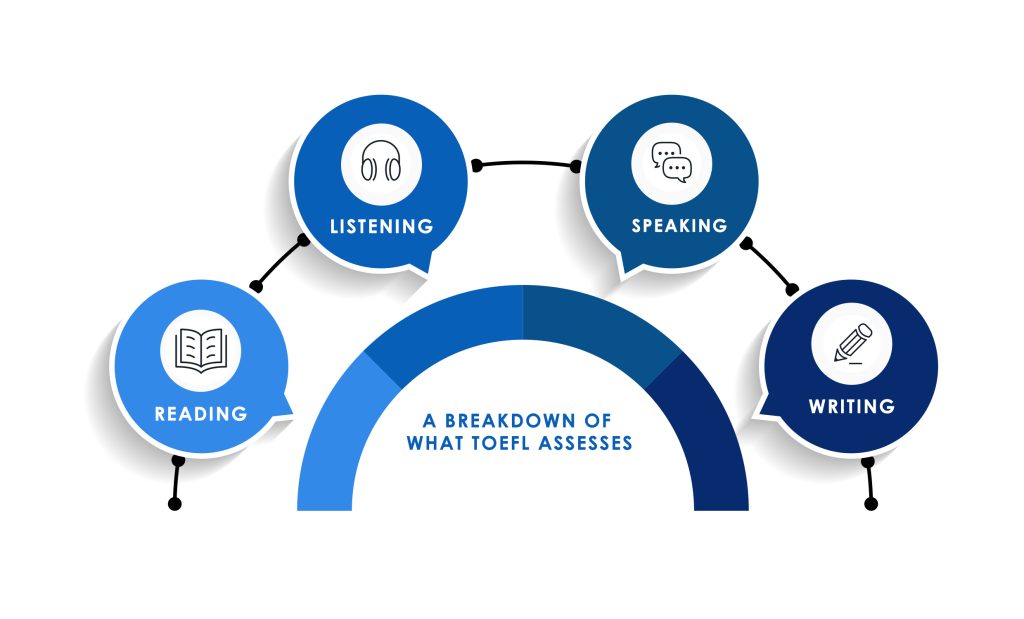
c. Types of tests available
- Internet based Test (iBT)
- Written Test
- At Home (iBT)
d. Sections
- Reading (54 minutes-72 minutes) – 3 to 4 passages with 10 questions each. Time limit is applicable for the entire task and not each passage. Ideally, 18 minutes per passage would be advisable
- Listening (41-57 minutes)- The timer stops while the recordings are played.
- Speaking (17 minutes)
- Writing (50 minutes= 20 minutes + 30 minutes)
CAAPID & TOEFL- The Unexpected Tryst
You might wonder- “Why does a future dentist need proficient English as a requisite aspect to being a dentist?”. The answer lies in the intricate dance between CAAPID and TOEFL. Although dentistry might seemingly appear to be a purely scientific and clinical field, effective communication is the foundational cornerstone of dentistry’s edifice. Let us further explain and discover how TOEFL plays a vital role in your CAAPID journey.
Importance of TOEFL for CAAPID
Amongst a myriad of reasons, here are a few aspects that TOEFL helps with the CAAPID process
- Efficient and Effective Communication with Patients: Dentists require solid English skills to communicate effectively with patients, explain procedures, and address concerns.
- Collaboration with colleagues/dental teams: TOEFL scores demonstrate your ability to collaborate effectively with dental professionals from diverse backgrounds.
- Access to Research and Continuing Education: Proficiency in English is essential for accessing dental research, attending conferences, and staying updated on the latest advancements in the field.
- Cultural Sensitivity: Understanding English can help you navigate cultural differences and provide culturally sensitive patient care.
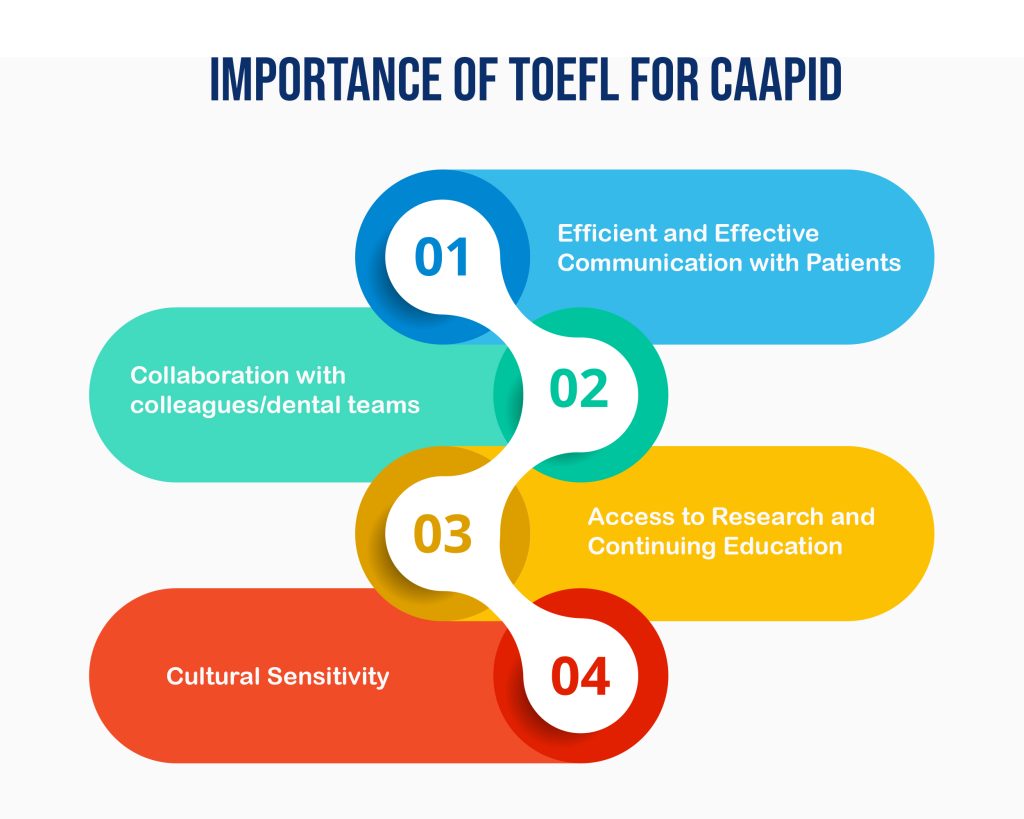
TOEFL tips for International Dentists applying to DDS or DMD {Dr. Nikita Rungta}
How to register for the TOEFL test
Registering for the TOEFL test is a straightforward process.
- Create an ETS Account: Visit the official TOEFL website (https://www.ets.org/toefl) and create an account.
- Choose a Test Date and Location: Select a test date and location that suits your schedule and preferences. Ensure you register well in advance, as test dates can fill up quickly.
- Pay the Test Fee: Pay the required test fee using your preferred payment method.
- Confirm Your Registration: Review your registration details and confirm your choice.
OLD v. NEW TOEFL PATTERN(S)
In July 2023, the TOEFL exam underwent significant changes, with the aim to streamline the testing process and reduce anxiety for test-takers like yourself. This new format continues as of Nov 2024, and features shorter sections, fewer reading passages, and a revised writing section. Let us delve deeper and compare the specific changes in the old and new patterns:
Sl.No | SECTION | OLD FORMAT | NEW/CURRENT FORMAT |
1. | Reading | 3-4 passages, 10 questions each | 2 passages, 10 questions each |
2. | Listening | 3-4 lectures, 6 questions each; 2-3 conversations, 5 questions each | 3 lectures, 6 questions each; 2 conversations, 5 questions each |
3. | Speaking | 4 tasks (2 independent, 2 integrated) | 4 tasks (2 independent, 2 integrated) |
4. | Writing | 1 independent writing task, 1 integrated writing task | 1 integrated writing task, 1 academic discussion task |
Key Features of the New TOEFL Format
- Shorter Test Duration
- Fewer Reading Passages
- New Writing Task: The independent writing task has been replaced with a shorter academic discussion task.
- Elimination of Unscored Sections: All sections now contribute to the final score.
These changes are intended to reduce stress and potentially better your scores. Most question types remain the same, so you can continue using existing preparation materials except for the new writing task. These changes have contributed to a more seamless and efficient testing experience.
TOEFL v. IELTS
Both TOEFL and IELTS are widely accepted English language proficiency tests. However, they differ in their format and scoring. TOEFL is primarily computer-based, while IELTS offers both computer-based and paper-based formats. TOEFL uses a point-based scoring system, while IELTS uses a band score system. The speaking section of TOEFL is computer-based, whereas IELTS involves a face-to-face interview with an examiner. In terms of writing, TOEFL includes both integrated and independent writing tasks, while IELTS focuses on academic writing tasks.
Let us compare the two:
Sl.No | Feature | TOEFL | IELTS |
1. | Full form | Test of English as a Foreign Language (TOEFL) | International English Language Testing System (IELTS) |
2. | Format | Computer-based | Computer-based or writing-based |
3. | Scoring | Points (0-120) | Bands (0-9) |
4. | Speaking | Computer-based | Face to face |
5. | Listening | Lectures, conversations, listening comprehension, and multiple-choice questions | Lectures, conversations, multiple-choice questions |
6. | Reading | Academic texts, reading comprehension, multiple-choice questions and sentence completion, | Academic texts, multiple-choice questions, sentence completion, matching headings, and summary completion |
7. | Writing | Integrated and Independent | Two Academic tasks: |
School-specific TOEFL requirements (tabular format)
“The University of Minnesota accepts My Best Score”
– As confirmed by an applicant, after speaking with the admissions representative from the University of Minnesota.
TOEFL Unveiled: Understanding the New Regime with Dr. Aakash Malik | Caapid Simplified
How to prepare for TOEFL
Preparing for the TOEFL can be a daunting task, but with the right approach and dedication, you can achieve your desired score. Let’s hear from Amirtha, a high-scorer who shares her valuable insights:
Preparation Tips
- Start Early: Begin your preparation at least 6 weeks in advance.
- Take a Diagnostic Test: Identify your strengths and weaknesses.
- Focus on Weak Areas: Devote more time to sections where you struggle.
- Practice Regularly: Consistent practice is key to success.
- Use Effective Strategies: Employ techniques like skimming, scanning, and note-taking.
- Simulate Test Conditions: Practice in a quiet environment, similar to a test center.
- Seek Feedback: Get your writing and speaking evaluated by experts or peers.
- Manage Time Wisely: Practice time management to avoid rushing.
- Stay Calm and Confident: Use relaxation techniques to reduce anxiety.
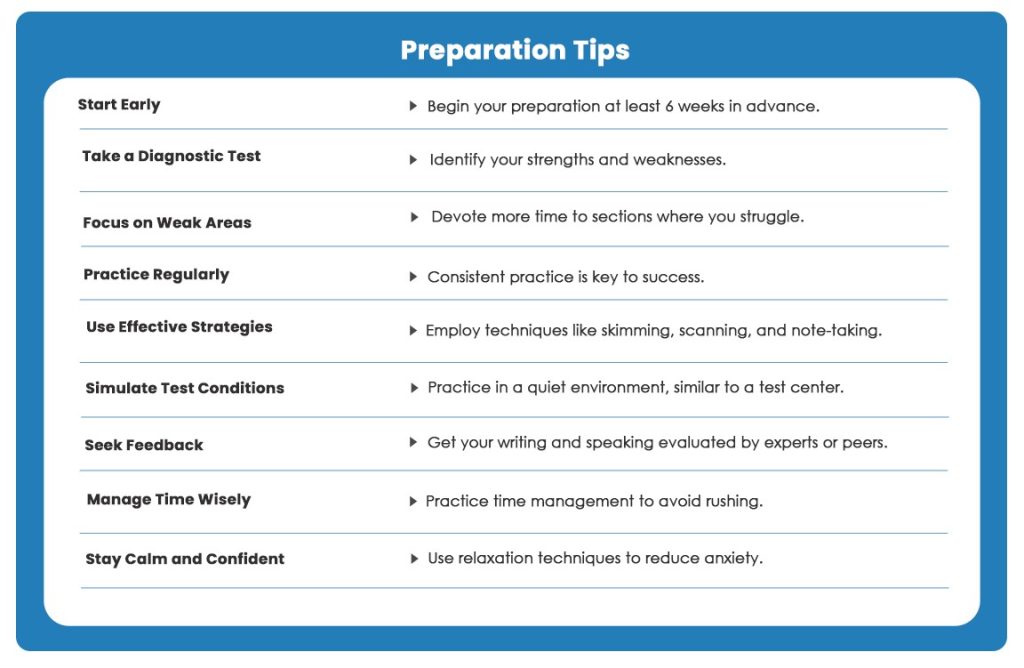
TOEFL Tips: FAQs with Top Scorer Amirtha
Question 1. How long before the test did you start preparing?
I started my preparation approximately 6 weeks before my test date.Question 2. What was your initial step in preparation?
Right when I decided to start preparation, my first step was to take a full sample test to understand where I currently stand. After taking this sample test, I identified areas where I struggled while I was taking it and also based on my results in each section.Question 3. Can you elaborate on the 2-2-2 method you mentioned?
The first 2 weeks of the 2-2-2 method was to focus solely on the components I found the hardest first. Personally, that was speaking and reading. For speaking, I would make sure I converse in proper sentences and avoid colloquial language/slang. I would give myself random prompts and prep in the stipulated time and record my natural response. I would then replay my recording and identify areas I went wrong and re-record my response. This method not only helped me find out my problem areas but also reinforced a sense of confidence after I listened to the second recording. For reading, I would skim through the passage first and get an idea of the topic given. I would then attempt the questions. If I was not sure of the exact answer, I would be able to identify the paragraph where the answer would be hidden from the initial skim. This technique helped me save time and gave me the chance towards the end to re-check my answers, which I was not able to do when I read the passage fully with intent before answering the questions. This was a personal preference, however, you can find the best method for you and work with that.
The second 2 weeks of the 2-2-2 method was to start practicing the other components of the test (listening and writing), while I still kept in touch with the other two components I had to work on. For speaking, listening, and writing, I found out effective note-taking did wonders. I would advise writing in short forms/phrases/symbols that you can understand while referring to the notes, as this would save time and you can focus on framing/developing and answering. I found making a comparative table helped me keep my thoughts organized, when two sides of an argument were presented. For this 2 weeks, mix up the permutation and combinations you practice each component, so you don’t end up exhausted on one particular component.The last 2 weeks of the 2-2-2 method was to do full practice tests. By this time, you should be pretty familiar with each component and the kind of questions that can come up. The point of the practice tests is it simulates a test-like environment so you’re used to the timing and the amount of focus you need to put in. Try to avoid taking breaks during the test as the test center may not allow the same. Try to get your writing assignments evaluated preferably by a human/AI. It helped me to have a few template sentences which I could easily modify according to the task. This helped me build a structured answer especially for the academic writing task. Keep a track of your progress with each practice test. If you have a target score in your mind, set an overestimate score you would like to achieve for each component of the test. Lastly, if you know you’re good with one or two components of the test, make sure you give it your all on those components during the real test! Trust your gut!
Question 4. What are the sources you relied on to study or prepare?
I used the one-month subscription of BestMyTest for my prep. I started to use it from the 3rd week of my 6-week prep. This subscription came with a limited number of human and AI reviews which I used wisely, mainly saving them for the full practice tests.Question 5. How did your friends/family help?
During the initial days of my prep, I would practice speaking with my parents and sister. I found this comfortable for me, especially when I just started out with preparation, as talking to a human felt easier than to a computer screen. Ask your friends/family for constructive criticism, they may point out areas you can improve that you had missed out/did not realize.Question 6. Is it helpful to take the practice tests in a relatively busy/noisy environment if one is easily distracted?
That is definitely something you can do, especially if you get distracted easily. The test center will have candidates taking different types of tests/start their TOEFL test at a different time than you, which means you may be able to hear them speak while you are doing a whole different component. I would say try to simulate a similar environment – laptop, desk, paper pens, and headphonesQuestion 7. What are some tips you’d give applicants who are confident preparing but diffident to take the exam?
- Practice helps build confidence!
- Test centre may get you feeling intimidated with the other candidates present there, but just trust your prep and go with your gut!
Question 8. Any additional tips for our applicants?
- Your test is evaluated by a human aided by computer software, so make sure your grammar is right.
- Having a few template introductory/transition/conclusion phases helped me build a structured response. Make sure it can be easily modified to suit the tone of your response on test day
- Carry a water bottle and a small snack with you, you’ll be able to store it in your assigned locker. You will be allowed to leave the testing hall at the loss of your time during the reading and listening components, or between those two. However you will not be allowed to exit once speaking and writing components start. So make sure you take your breaks in the stipulated time/or before you start the test.
- Finally, all the best!!
Recommended Resources
- BestMyTest: A valuable online resource for practice tests and expert feedback.
- Notefull videos
- Magoosh blogs, videos and 1 month/ 6-month subscription
- ETS- Website, Quick prep and official Guide
- Barron’s
- Princeton Review
- Manhattan Prep
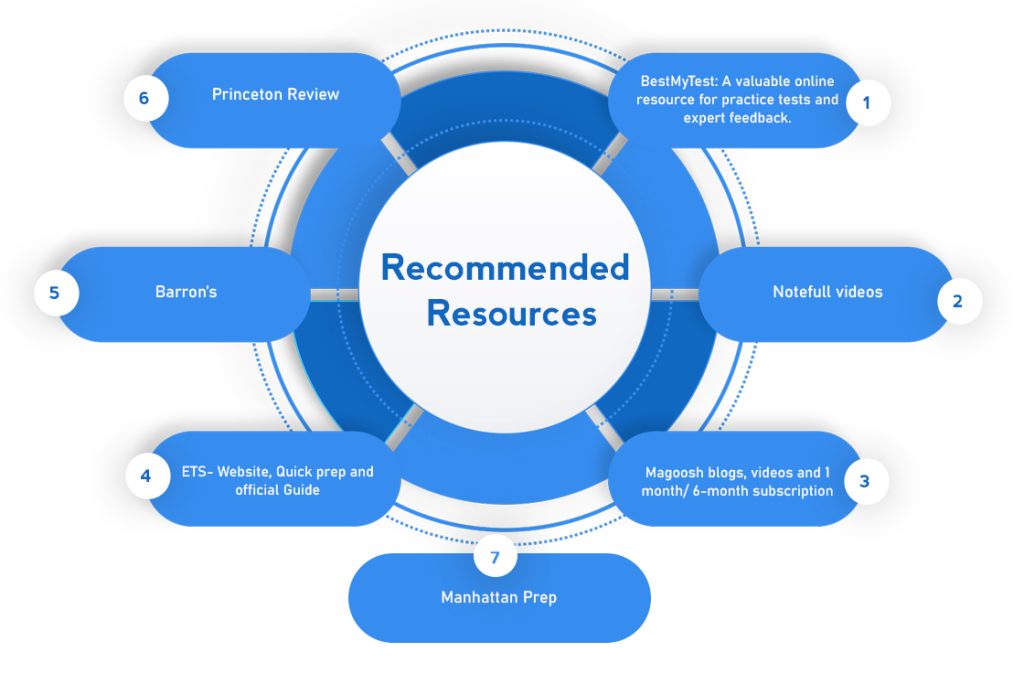
Additional resources
- Podcasts
TED talks daily (Every weekday; Pioneers from various industries throw light on the recent advancements in a multitude of fields)
The Economist (Every weekday; Covers current affairs, finance, science and technology)
BBC Global News Podcast (Twice a day on weekdays, daily on weekends)
BBC World Service- News Review (updated on a weekly basis; explains how to use the language from the latest news in one’s everyday English) - Documentaries
- Rachel’s English (This channel can enable correct pronunciation of English words)
- Purdue OWL- Can be used for the assessment of the practice essays
- Grammarly- This can be used to weed out errors in grammar and punctuation. In addition, it can be used for the purpose of paraphrasing.
- Magoosh Vocabulary Flashcards application(To learn the meaning and usage of words within a wide range of difficulty levels)
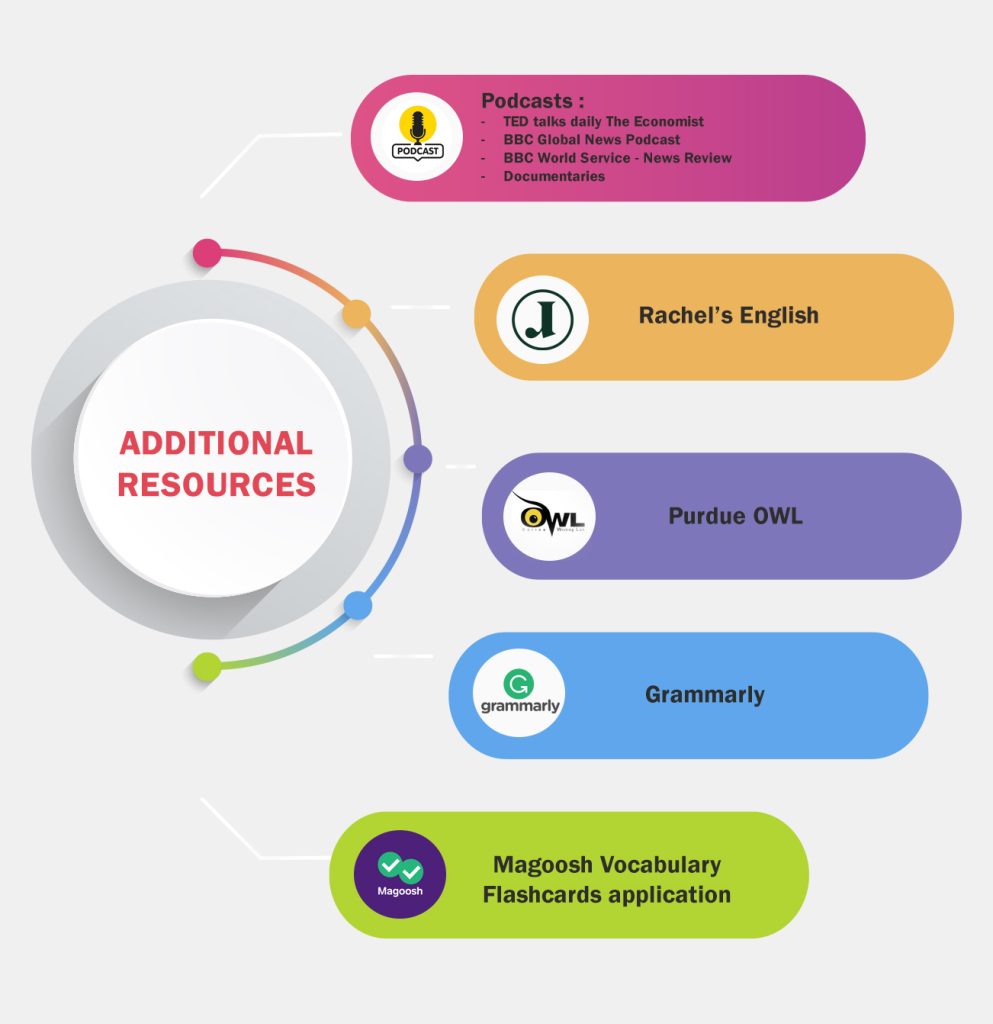
Additional Tips
- Build Vocabulary and Grammar: Enhance your language skills.
- Practice Speaking Fluently: Engage in conversations with native speakers or language partners.
- Use Template Sentences: Structure your writing and speaking responses effectively.
- Take Breaks: Short breaks can help you stay focused.
- Stay Hydrated: Drink water to stay alert.
- Trust Yourself: Believe in your preparation and abilities.
CONCLUSION
You’ve navigated the complexities of the TOEFL, from understanding its structure to mastering effective study techniques and tools, peppered with additional expert tips. With this knowledge, you’re well-prepared to conquer this linguistic hurdle and unlock the doors to a bright future in dentistry. Remember, every journey starts with a single step. So, take that first step, and let’s make your TOEFL journey a success story, and one day soon enough, you can be the TOEFL expert giving other aspirants like yourself, tips to ace the test!


